How To Repair A Water Line Underground

We're back with our next Pro-Follow, and this one hits close to home. If you entered Fred's Husky Tool Tote Giveaway, you probably read the brief update at the end where he shares that today'due south Pro-Follow comes to you from my house.
Before this month, Jocie and I noticed that our water pecker was significantly higher than usual.
Seeing nothing amiss in our home, we called the utility company expecting there had been a clerical error or perhaps a malfunctioning water meter. Instead, they suggested we might take an underground leak betwixt our house and the meter, and they were right. I chosen a plumber I trust, and this article explains how he and his coiffure repaired the underground leak.
All of our Pro-Follow manufactures showcase professional contractors on actual job sites, and we share how they tackle home improvement projects with tips along the way. If you like learning from the pros, become an email subscriber and never miss an update.
Steps to Repair a Cleaved, Underground Pipe
The plumbers presented 2 strategies for fixing the leak. One arroyo would be to replace the entire length of copper piping between my house and the meter by securing a cable at 1 end and pulling the old pipe and a new one (fastened at the other end) through the ground. This would require minimal excavation and less labor; however, copper is expensive and this solution would exist also. I opted for the second arroyo, which was to dig down to the pipe at the leak location and replace a small section of the pipe.
Pro-Tip: On newer construction, yous may run across black, high-density polyethylene (HDPE) pipe in lieu of copper, considering it is less expensive.
Pro-Tip: Copper water pipe has an expected lifespan of 50-lx years.
Step 1: Accept All Underground Utilities Marked
Upon closer inspection of my yard, the full general location of the leak was pretty obvious because of the mud, but before piece of work could commencement, the plumbers needed all the undercover lines located. Here in Maryland, we phone call Miss Utility before every dig. An Emergency Excavation Detect was filed, and inside a few hours, all surreptitious communications, gas, and power were marked.
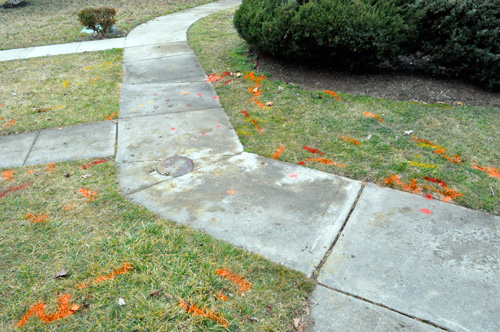
Step ii: Turn off Water at the Principal on the Street
Start, they needed to plough off the h2o supply at the meter establish at the sidewalk. This flick shows the meter, which has been completely submerged past the leak. Judging by how fast the meter was moving, the leak was sizable.
[See also: How to Plow off the Water at the Street]
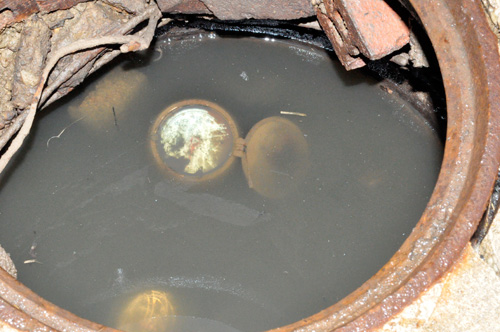
Stride three: Hand Dig Downwards to the Leak Location
Unfortunately, power, h2o and communications all enter my firm at about the aforementioned point (right around the leak), which meant that they needed to dig very slowly and carefully to avert damaging annihilation.
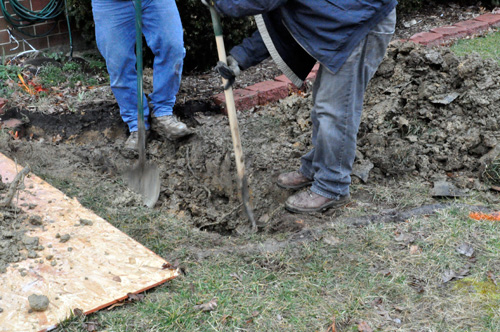
Pro-Tip: Communication lines similar phone and cable service are commonly found within 24″ of the surface. Water supply lines are typically buried 36-42″ deep, or deeper if you live in an extremely common cold climate.
Pro-Tip: When excavation, orient your shovel forth the cached line (rather than across) until it has been fully exposed. Yous're much less likely to inadvertently cause damage. It should go without saying: never use mechanical tools to dig near undercover utilities.
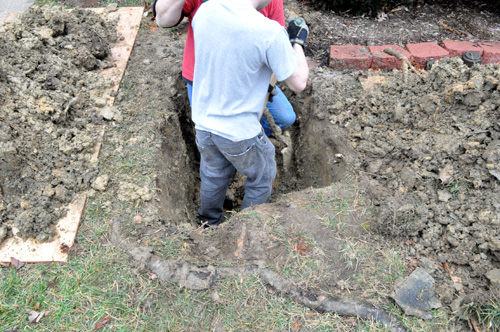
In fourth dimension, they institute blackness power lines, and they excavated effectually them to provide adequate clearance.
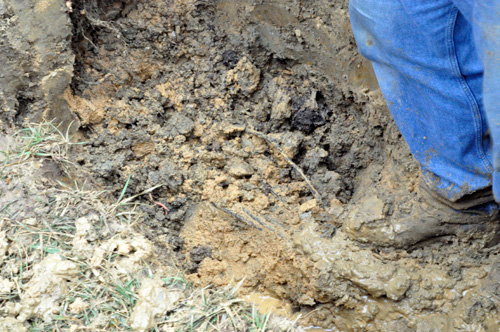
Step iv: Pinpoint the Location of the Leak
The plumbers would turn on the water supply for brief moments to help decide the location of the leak.
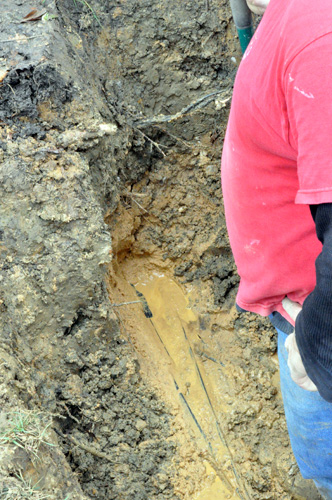
Eventually, they found the water line within a PVC sleeve. Builders would often run h2o supply lines through a short segment of PVC as it passed through the foundation, so it was odd that we should discover the sleeve extended about vii′ away from the house. Upon turning on the water supply, information technology was found that the leak occurred somewhere inside this PVC sleeve.
Pro-Tip: While not the case in this home, in the late 80s builders frequently used a material called polybutylene for h2o pipe. This material was in one case thought of as "the pipe of the hereafter" considering information technology was flexible, easy to work with, and cheap. Unfortunately, the lifespan of polybutylene turned out to exist relatively short (fifteen years). One repair method for failed polybutylene pipe is to run copper pipage through the polybutylene. If you come across a leak in an underground supply pipage that looks like PVC, and your house was in the 80s, you should be aware of this potential situation.
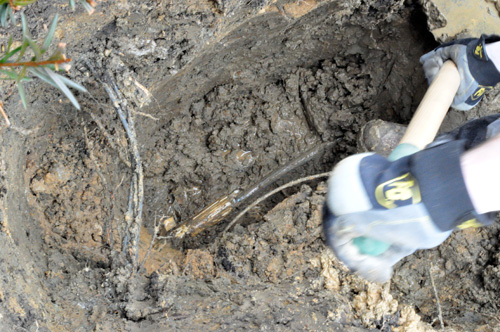
Step five: Cutting Abroad and Remove the Old Pipe, Install the New Pipage
This close to the business firm, they determined it would be best to supplant an 8′ section going all the way inside. They cut the piping just before the PVC sleeve, and we headed inside to cut and remove the onetime piping.
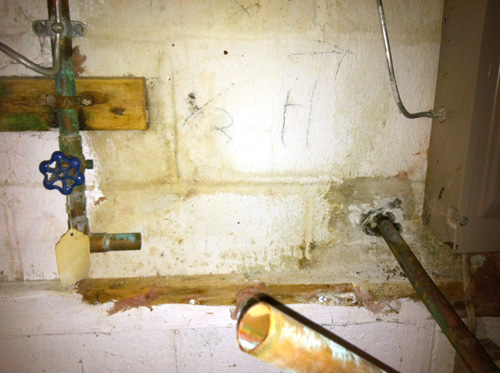
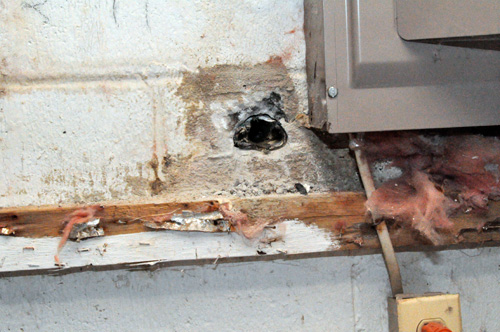
The crew attempted to push a new slice of copper pipe through the hole and PVC sleeve, simply it would not go. To feed the new line, they snaked a cable through the PVC sleeve. The plan was to solder a softer, more than flexible copper pipe onto the cable and pull it through (much like the alternative arroyo I shared at the outset.)
Here's a picture of the new 3/4″, K copper supply line.
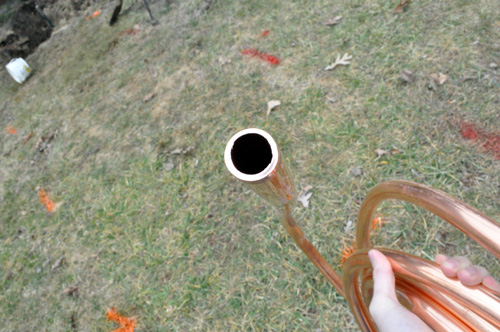
Pro-Talk: Copper pipe wall thickness is designated by letter K, Fifty or Thou. Type Grand copper pipe is much thicker than L or M. Type L is the second thickest.
They soldered the pipe to a coupling fitted on the cable, and setup a winch outside to pull the pipe through.
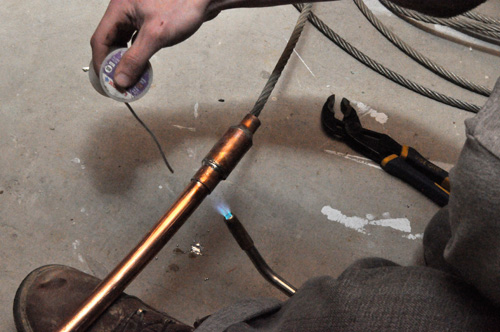
Pro-Tip: See our full tutorial to learn how to solder copper pipage.
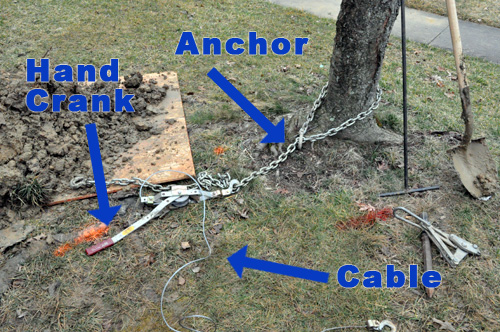
When everything was fix, the crew began pulling the pipe through, and information technology actually dislodged the PVC sleeve. If you wait closely at the picture beneath, you lot'll come across a precipitous bend in the PVC. The plumbers are non sure how that occurred, but that is definitely the reason why they could not feed the replacement pipe through by mitt.
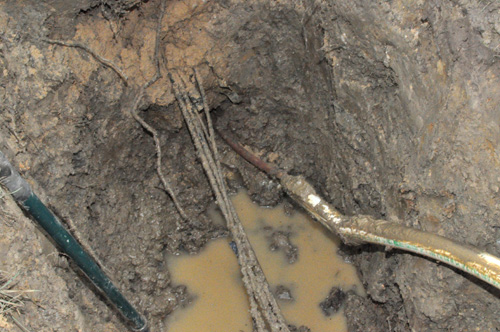
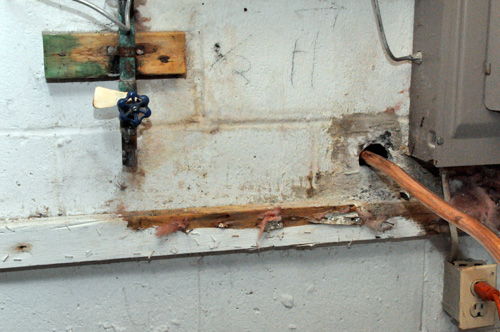
Pace 6: Make Connections with the Existing Pipe
Pace 6a: Outdoor Joints
A solder joint isn't appropriate for a cached line, so instead they used a pack-joint coupling to connect the new pipe to the existing supply line in the ground exterior. Unfortunately, I don't have a picture of this step, but yous tin can Google for pack-joint coupling and discover a practiced amount of information on it. Next, they turned on the water to flush out whatsoever dirt or debris.
Step 6b: Indoor Joints
Adjacent, the crew went well-nigh connecting the new line inside my house, which involved unproblematic copper soldering. If you're curious well-nigh that plumbing fixtures in the center, it's a compression fitting chosen a SharkBite. When they installed the new, 90° elbows, one of the joints wasn't properly soldered. When they turned on the water, a small pin-hole leak was evident. Unfortunately, it'south incommunicable solder a pipe when it's full of h2o. To address this, they cut the pipe in the middle, drained the water, re-soldered the elbow then used a SharkBite (which doesn't require soldering) to repair the cut. In Maryland, SharkBite fittings are fully code-compliant for indoor apply.
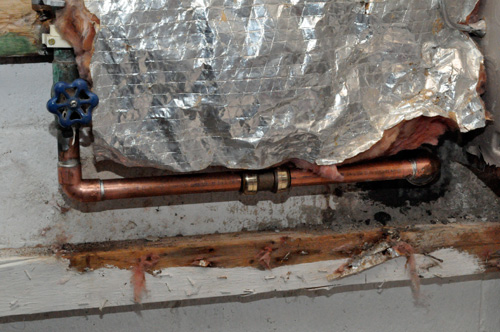
Step 7: Seal upwardly the Pipe Archway Points into the House to Forestall Leaks
Here's a closeup showing where the pipe enters my house. You tin can see the plumbers placed a new PVC sleeve that extends a few inches beyond the foundation, and they used a clear, silicone sealant to make full the space around the copper pipe. They too used a hydraulic cement to repair the area effectually the PVC sleeve.

Stride 8: Check and Confirm That the Pipes Are Leak-Costless
The coiffure re-tested the line and confirmed that the pipes were leak-gratuitous.
Of form, they repaired the front lawn, and I'll be reseeding the surface area in the next few days.
If you enjoyed this article, check out some of the other Pro-Follows we take going on right now.
Source: https://www.oneprojectcloser.com/how-to-repair-underground-water-pipe/
Posted by: hurlbutmonatur.blogspot.com


0 Response to "How To Repair A Water Line Underground"
Post a Comment